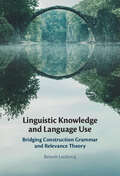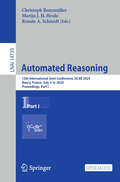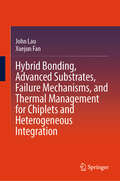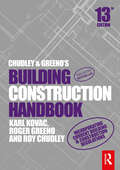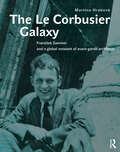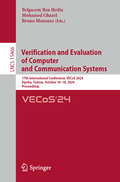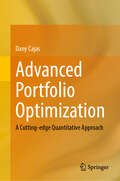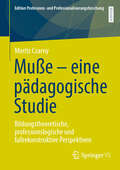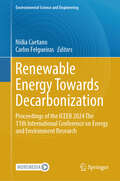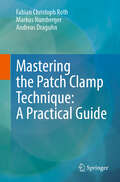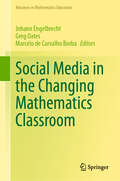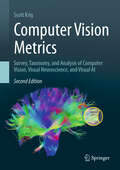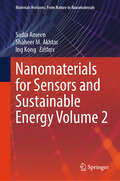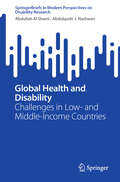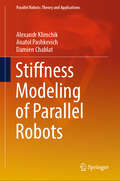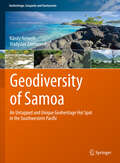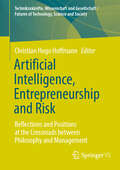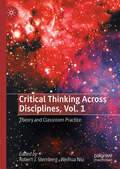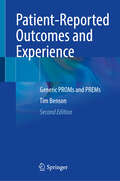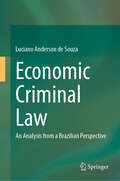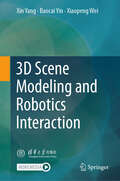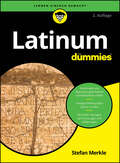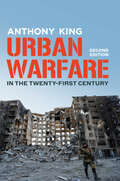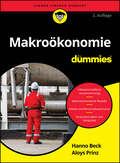- Table View
- List View
Linguistic Knowledge and Language Use: Bridging Construction Grammar and Relevance Theory
by Benoît LeclercqOne of the key challenges in linguistics is to account for the link between linguistic knowledge and our use of language in a way that is both descriptively accurate and cognitively plausible. This pioneering book addresses these challenges by combining insights from Construction Grammar and Relevance Theory, two influential approaches which until now have been considered incompatible. After a clear and detailed presentation of both theories, the author demonstrates that their integration is possible, and explains why this integration is necessary, in order to understand exactly how meaning comes about. A new theoretical model is offered that provides ground-breaking insights into the semantics-pragmatic interface, and addresses a variety of topics including the nature of lexical and grammatical concepts, procedural meaning, coercion and idiom processing. This title is part of the Flip it Open Programme and may also be available Open Access. Check our website Cambridge Core for details.
Automated Reasoning: 12th International Joint Conference, IJCAR 2024, Nancy, France, July 3–6, 2024, Proceedings, Part I (Lecture Notes in Computer Science #14739)
by Renate A. Schmidt Christoph Benzmüller Marijn J. H. HeuleThis two-volume set of LNAI 14739-14740 constitute the proceedings of the 12th International Joint Conference on Automated Reasoning, IJCAR 2024, held in Nancy, France, during July 3-6, 2024. The 39 full research papers and 6 short papers presented in this book were carefully reviewed and selected from 115 submissions. The papers focus on the following topics: theorem proving and tools; SAT, SMT and Quantifier Elimination; Intuitionistic Logics and Modal Logics; Calculi, Proof Theory and Decision Procedures; and Unification, Rewriting and Computational Models. This book is open access.
Hybrid Bonding, Advanced Substrates, Failure Mechanisms, and Thermal Management for Chiplets and Heterogeneous Integration
by Xuejun Fan John LauThe book focuses on the design, materials, process, fabrication, failure mechanism, reliability, modeling, and thermal management of chiplets and heterogeneous integration. Both principles and engineering practice have been addressed, with more weight placed on engineering practice. This is achieved by providing in-depth study on a number of major topics such as hybrid bonding, advanced substrates, failure mechanisms, and modeling due to thermal stresses, moisture absorption, impact loading such as drop as well as electric current driven electromigration, and the fundamentals of thermal management. Each topic is treated with in-depth analysis to bridge foundational principles with real-world engineering challenges. This book is an essential resource for researchers, engineers, and students in electrical engineering, mechanical engineering, materials science, and industrial engineering, equipping them with the knowledge to advance innovation in semiconductor packaging and integration.
Chudley and Greeno's Building Construction Handbook
by Roy Chudley Roger Greeno Karl KovacThe 13th edition of Chudley and Greeno’s Building Construction Handbook remains THE authoritative reference for all construction students and professionals. The principles and processes of construction are explained with the concepts of design included where appropriate. Extensive coverage of building construction practice, techniques and regulations representing both traditional procedures and modern developments are included to provide the most comprehensive and easy-to-understand guide to building construction.This new edition has been updated to reflect recent changes to the Building Regulations, as well as including new material on modern methods of construction, greater emphasis on sustainability, health and safety, and coverage of heat pumps, photovoltaics, underfloor heating and rainwater harvesting.Chudley and Greeno’s Building Construction Handbook is the essential, easy-to-use resource for undergraduate and vocational students on a wide range of courses including NVQ and BTEC National, through to Higher National Certificate and Diploma, to Foundation and three-year degree level. It is also a useful practical reference for building designers, contractors and others engaged in the construction industry.
The Le Corbusier Galaxy: František Sammer and a global network of avant-garde architects
by Martina HrabováDrawing on the author‘s discovery of an unknown, long-forgotten collection of photographs in an Indian ashram, this book offers an exciting, new view of the international community of young architects who served as Le Corbusier‘s assistants in the inter-war years. A collection of some 500 snapshots, assembled by the Czech architect František Sammer between 1931 and 1939, had been stored unnoticed for more than 70 years in an unlikely location – the Sri Aurobindo Ashram in Pondicherry, India. Sammer was one of Le Corbusier‘s closest assistants from the early 1930s. Later, Sammer worked in the Soviet Union, Japan and India. During, and after, his time in Paris, he personally took or collected these photographs, which he then deposited at the ashram when he left to fight in World War II. The images offer a remarkable view of the international community of people who worked in Le Corbusier’s atelier in the 1930s. Among those featured in the photographs are Charlotte Perriand, Pierre Jeanneret, Jane West (the first American woman to work for Le Corbusier), Gordon Stephenson, Antonin Raymond, Junzo Sakakura and Josep Lluís Sert. Given the travels and international background of these individuals, the photographs are from different countries around the world, including the USSR, England, France, Czech Republic, Greece, USA (Tennessee, Montana, California and New Mexico), Japan and India. The Le Corbusier Galaxy successfully brings together serious archival research with a fascinating narrative, and it captures the human dimension of modern architecture, which is all too often neglected in today’s accounts.
Verification and Evaluation of Computer and Communication Systems: 17th International Conference, VECoS 2024, Djerba, Tunisia, October 16–18, 2024, Proceedings (Lecture Notes in Computer Science #15466)
by Bruno Monsuez Belgacem Ben Hedia Mohamed GhazelThis book constitutes the refereed proceedings of the 17th International Conference on Verification and Evaluation of Computer and Communication Systems, VECoS 2024, held in Djerba, Tunisia, during October 16–18, 2024. The 16 full papers included in this book were carefully reviewed and selected from 42 submissions. They deal with the state of the art and challenges in modern computer and communication systems in the areas of verification, control, performance, and dependability evaluation.
Advanced Portfolio Optimization: A Cutting-edge Quantitative Approach
by Dany CajasThis book is an innovative and comprehensive guide that provides readers with the knowledge about the latest trends, models and algorithms used to build investment portfolios and the practical skills necessary to apply them in their own investment strategies. It integrates latest advanced quantitative techniques into portfolio optimization, raises questions about which alternatives to modern portfolio theory exists and how they can be applied to improve the performance of multi-asset portfolios. It provides answers and solutions by offering practical tools and code samples that enable readers to implement advanced portfolio optimization techniques and make informed investment decisions. Portfolio Optimization goes beyond traditional portfolio theory (Quadratic Programming), incorporating last advances in convex optimization techniques and cutting-edge machine learning algorithms. It extensively addresses risk management and uncertainty quantification, teaching readers how to measure and minimize various forms of risk in their portfolios. This book goes beyond traditional back testing methodologies based on historical data for investment portfolios, incorporating tools to create synthetic datasets and robust methodologies to identify better investment strategies considering real aspects like transaction costs. The author provides several methodologies for estimating the input parameters of investment portfolio optimization models, from classical statistics to more advanced models, such as graph-based estimators and Bayesian estimators, provide a deep understanding of advanced convex optimization models and machine learning algorithms for building investment portfolios and the necessary tools to design the back testing of investment portfolios using several methodologies based on historical and synthetic datasets that allow readers identify the better investment strategies.
Muße – eine pädagogische Studie: Bildungstheoretische, professionslogische und fallrekonstruktive Perspektiven (Edition Professions- und Professionalisierungsforschung #18)
by Moritz CzarnyIn Zeiten rastloser Betriebsamkeit dürfte das Verhältnis von Muße und Bildung zu den vielzitierten ‚vergessenen Zusammenhängen&‘ (Mollenhauer) gehören. Die vorliegende erziehungswissenschaftliche Studie regt dazu an, die Bedeutung der Muße für die Pädagogik unter professionstheoretischen Gesichtspunkten neu zu betrachten. Im Anschluss an die pädagogische Ideengeschichte und an das Modell der ‚Krise durch Muße&‘ in der strukturtheoretischen Professionstheorie zeigen objektiv-hermeneutische Fallstudien Perspektiven für die Habitusbildung und das professionelle Handeln in pädagogischen Arbeitsbündnissen auf.
Renewable Energy Towards Decarbonization: Proceedings of the ICEER 2024 The 11th International Conference on Energy and Environment Research (Environmental Science and Engineering)
by Carlos Felgueiras Nídia CaetanoThis book contains the full papers of the 11th edition of the International Conference on Energy and Environment Research, ICEER 2024, that took place in Coimbra, Portugal during July 24–26, 2024. ICEER 2024 is a joint organization of the School of Engineering (ISEP) of the Polytechnic of Porto (P.Porto) and the SCIEI. This book includes all the well prepared full papers presented at ICEER 2024.
Mastering the Patch Clamp Technique: A Practical Guide
by Markus Numberger Andreas Draguhn Fabian Christoph RothThe patch clamp technique is one of the most important electrophysiological methods in use today. Its application in basic biomedical research has provided significant insights into the function and properties of ion channels, making it equally indispensable in applied pharmacological research. This book is the English edition of the popular German introduction to the patch clamp technique. This introductory book serves as a practical guide for teachers and students, offering clear and practical instructions on patch clamp recordings. The authors provide essential information to establish and successfully apply this method in the laboratory. The book covers the basics of measurements, the detailed setup of a patch clamp rig and how to carry out typical recordings. It also includes concrete tips and tricks to help with troubleshooting, making it an indispensable resource. The book not only highlights the enormous potential of the method for the study of ion channels and cell signaling, but also provides an introduction to the major developments and variations of the technique. The book is aimed at advanced students of biology, biochemistry, medicine, pharmacy and related disciplines as well as scientists who want to better understand and/or acquire the technique.
Social Media in the Changing Mathematics Classroom (Advances in Mathematics Education)
by Johann Engelbrecht Greg Oates Marcelo de Carvalho BorbaThis edited volume gathers contributions from international scholars focusing on social media's role and impact on mathematics education. Social media's integration into pedagogical strategies (from social networking sites to video-sharing platforms) offers the opportunity to enhance learning by fostering connectivity and engagement among students, ultimately improving mathematical understanding in educational settings. This text aims to provide guidance on the facilitation of peer learning and collaboration, as well as highlighting the necessary shift in traditional methods to include cyber assistance in the learning process. The book discusses how social media aligns with social-constructivist theories of learning, its consistency with the process of developing students into independent learners and provides means to ensuring educators remain relevant and connected to students' preferred modes of learning. Challenges and benefits of the use of social media tools in teaching are also detailed. Examining the potential for effective integration of social media in the classroom, this book is a valuable resource for educators, practitioners and researchers interested in mathematics education.
Computer Vision Metrics: Survey, Taxonomy, and Analysis of Computer Vision, Visual Neuroscience, and Visual AI
by Scott KrigThis 2nd Edition, based on the successful 2016 textbook, has been updated and expanded to cover 3rd generation Computer Vision and AI as it supersedes historical visual computing methods, providing a comprehensive survey of essential topics and methods in Computer Vision. With over 1,200 essential references, as well as chapter-by-chapter learning assignments, the book offers a valuable resource for students, researchers, scientists and engineers, helping them dig deeper into core computer vision and foundational visual computing and neuroscience topics. As before, a historical survey of advances in Computer Vision is provided, updated to reflect the latest methods such as Vision Transformers, attention models, alternative features such as Fourier neurons and Binary neurons, hybrid DNN architectures, self-supervised and enhanced learning models, Associative Multimodal Learning, Continuous Learning, View Synthesis, intelligent Scientific Imaging, andadvances in training protocols. Updates have also been added for 2d/3d cameras, software libraries and open source resources, computer vision cloud services, and vision/AI hardware accelerators. Discussion and analysis are provided to uncover intuition and delve into the essence of key advancements, applied and forward-looking topics.
Nanomaterials for Sensors and Sustainable Energy Volume 2 (Materials Horizons: From Nature to Nanomaterials)
by Sadia Ameen Ing Kong Shaheer M. AkhtarThis book offers readers an extensive insight into advanced nanomaterials and their applications in the realm of energy generation and utilization. It places a specific emphasis on emerging nanomaterials and their diverse applications within energy-related sectors and sensor technology. The primary focus is on comprehending how these materials enhance the performance of energy storage devices and sensors. Furthermore, the book provides a comprehensive overview of the significant challenges faced in these areas and presents a forward looking perspective. Comprising ten chapters, the book extensively explores the applications of nanomaterials in energy-related fields, specifically in solar cells, supercapacitors, sensors, and more. It caters to the needs of budding researchers involved in the synthesis of nanomaterials and post-graduate students interested in delving into the intricacies of nanomaterials.
Global Health and Disability: Challenges in Low- and Middle-Income Countries (SpringerBriefs in Modern Perspectives on Disability Research)
by Abdullah Al Shami Abdulqadir J. NashwanThis book aims to shed light on the pressing and often overlooked challenges faced by individuals with disabilities in low- and middle-income countries (LMICs). The book explores how structural barriers, limited resources, and socio-cultural factors contribute to the inequities in access to essential services such as health care, education, and employment for this vulnerable population. Through a detailed analysis, the book highlights the disparities that exist between high-income countries and LMICs, offering insights into the unique obstacles that individuals with disabilities encounter in these regions. This book is of particular importance to the field currently due to the growing recognition of disability as a critical aspect of global health and development. The recent focus on inclusivity in global agendas, such as the Sustainable Development Goals (SDGs), underscores the need for a comprehensive understanding of how disability intersects with poverty, inequality, and access to essential services.
Stiffness Modeling of Parallel Robots (Parallel Robots: Theory and Applications)
by Alexandr Klimchik Anatol Pashkevich Damien ChablatThe book focuses on the stiffness modeling of serial and parallel manipulators It presents fundamentals and enhancements for Virtual Joint Modelling (VJM), Matrix Structural Analysis (MSA) and Finite Element Analysis (FEA). The described techniques consider complex kinematics with numerous passive joints, different types of loadings, including essential loadings leading to critical changes in the manipulator configurations, linear and non-linear stiffness analysis, conventional and non-linear compliance error compensation and stiffness parameters estimation from virtual experiments. Presented enhancement for the VJM integrates in the stiffness analysis external force/torque applied to the end-point, internal preloading in the joints, and auxiliary forces/torques applied to intermediate points. The proposed technique includes computing an equilibrium configuration corresponding to the external/internal loading and allows obtaining the full-scale non-linear force-deflection relation for any given workspace point. This enables the designer to evaluate critical forces that may provoke non-linear behaviours of the manipulators, such as sudden failure due to elastic instability (buckling). The presented enhancement to the MSA allows users to carry out stiffness analysis for serial underactuated structures and over-constrained ones with multiple closed loops. To increase the model accuracy of the VJM and MSA techniques a dedicated FEA-based stiffness model parameters identification technique is introduced in the book. It is based on the virtual experiments in the CAD/CAE environment and allows the VJM and MSA to achieve accuracy comparable with FEA, but it essentially reduces the computational effort, eliminating repetitive re-meshing through the workspace. All considered stiffness modelling techniques, kinematic particularities and loading conditions are illustrated with practical examples and related analysis.
Geodiversity of Samoa: An Untapped and Unique Geoheritage Hot Spot in the Southwestern Pacific (Geoheritage, Geoparks and Geotourism)
by Károly Németh Vladyslav ZakharovskyiThis book represents a pioneering effort, offering a comprehensive summary of the Geoheritage of the Southwestern Pacific (SW Pacific). Despite its globally significant Geoheritage , the region has not yet been addressed in its entirety within a cohesive geocultural context, either in book form or through similar media. The SW Pacific is still emerging as a focal point of Geoheritage research, and exploration of the vast geodiversity of this region has only recently begun. While some initial scientific reports exist for specific areas within the SW Pacific, there has been no comprehensive summary covering the entire region. Although the region is primarily renowned for its picturesque beaches and tranquil coastal landscapes, its rich Geocultural aspects remain largely underutilized and understudied. It aims to fill this gap by providing a holistic exploration of the geodiversity and geoheritage of the Samoa islands. By offering an evidence-based and scientifically valid overview of the islands' geoheritage and geodiversity, the book seeks to serve as a foundational resource for future developments in the tourism sector and to define research directions and methodologies for expanding our understanding of volcanic oceanic islands' geoheritage. It will focus on geodiversity and geoheritage within the context of volcanic oceanic islands, which are unique in terms of their geological formations (such as volcanoes and lava fields) and their limited spatial extent within the vast Pacific Ocean basin. This book will also highlight the special coastal regions of volcanic oceanic islands, which often feature fringed reefs and broad shallow marine environments housing unique and fragile ecosystems sensitive to global and planetary changes. By estimating geodiversity, the book will provide insight into how volcanic islands' geoheritage intersects with biodiversity. Geodiversity will be explored as the backdrop for the evolution of tropical marine and mountainous biodiversity in spatially limited areas under tropical conditions. Moreover, this book aims to be a pioneering contribution, offering a methodological manual for exploring other islands from a geodiversity perspective. Currently, there is no similar publication on the market, making this book one of the first of its kind. The authors have conducted extensive research in Samoa, resulting in numerous high-level scientific publications and a wealth of information to be included in this book.
Artificial Intelligence, Entrepreneurship and Risk: Reflections and Positions at the Crossroads between Philosophy and Management (Technikzukünfte, Wissenschaft und Gesellschaft / Futures of Technology, Science and Society)
by Christian Hugo HoffmannThis book embarks on a thought-provoking journey that seeks to illuminate the intricate connections between the dynamic realms of AI, Entrepreneurship and Risk Management. This book illuminates the philosophical foundations of AI, examines the fundamental beliefs surrounding AI's nature, and its effects for the human condition. Drawing on the works of eminent philosophers, economists and business leaders alike, the authors of this volume engage in inspirational discussions on ethics, philosophy of technology, and the potential societal ramifications of advancing AI technologies. By grounding the exploration in philosophical reflections, the authors set the stage for a comprehensive understanding of AI's role in entrepreneurship and the inherent risks it entails.
Critical Thinking Across Disciplines, Vol. 1: Theory and Classroom Practice
by Robert J. Sternberg Weihua NiuThis edited collection adopts a multidisciplinary perspective on critical thinking, bringing together leading experts from fields such as psychology, philosophy, education, and creativity studies. It explores both the theoretical foundations and practical applications of critical thinking in the classroom. By integrating diverse approaches, the book aims to foster a richer dialogue and deeper understanding of critical thinking, while enhancing its application to address emerging challenges in the first quarter of the 21st century, including global pandemics, geopolitical tensions, and the rise of generative AI. Volume 1 offers a comprehensive survey of cutting-edge multidisciplinary research, laying the groundwork for Volume 2, which will delve into the application of critical thinking to contemporary issues such as artificial intelligence, misinformation, and health communication.
Patient-Reported Outcomes and Experience: Generic PROMs and PREMs
by Tim BensonThis revised edition shows how patient-reported outcome models (PROMs) and patient-reported experience models (PREMs) can help improve health outcomes and patient experience. The first section covers the core principles of PROMs and PREMs, including their strengths and weaknesses, reporting and analysis, while the second section covers measures of patient experience, health status, wellbeing, self-efficacy, individualized measures, social determinants of health, and impact evaluation. The final section covers topics such as noise, interoperability and quality-adjusted life years. Patient-Reported Outcomes and Experience: Generic PROMs and PREMs covers how to use these measures to improve the outcomes of healthcare services and associated patient experience. It is a critical resource for clinicians, managers, analysts and policymakers seeking an up-to-date reference on the latest developments in this rapidly expanding field.
Economic Criminal Law: An Analysis from a Brazilian Perspective
by Luciano Anderson SouzaThis book investigates the legitimacy of Economic Criminal Law. Initially, it examines the history of the intersection between criminal law and economy, aiming at finding a possible evolutionary trait. Then it defines what is meant by Economic Criminal Law, and whether it would be necessary and possible to subsume it to the protected interest theory. Subsequently it analyzes theories that intend to equate the administratisation of criminal law, highlighting the proposed administrative-punitive. Finally, the conclusion searches for the best legal construction of the rules for economic infractions, limiting the role of criminal law in this context. The imperiousness of effective protection of the economic environment seems undeniable today. The structure of post-industrial capitalist system reveals, paradoxically, features unwanted by the existing mode of production, which the contemporary sociology understands as the reflexivity of risk society. In this sense, the economic agents undertake conduct detrimental to the conformation of the economic society, undermining the smooth functioning of the economy itself. In this context, the law, especially the criminal law, is used to try to head them off. It happens that such employment of legal and judicial branch clashes with their traditional boundaries, delineated since the Enlightenment. Complex economic behavior are criminally prohibited, in most cases through typifying proactive formulations, which are inconsistent and display as mere means of behavioral conformation, subject to administrative jurisdiction, which leads to the administrativization of the criminal law.
3D Scene Modeling and Robotics Interaction
by Xin Yang Baocai Yin Xiaopeng WeiThis book focuses on the intelligent perception and interaction module in intelligent robotic systems, establishes a multidisciplinary cross-fertilization knowledge system, explores the related technology frontiers and research frontiers as comprehensively as possible from the perspective of scene modeling and understanding, and develops a practical exposition of practical application tasks such as robotic navigation, obstacle avoidance, and grasping. The main contents of this book include 3D reconstruction, scene exploration, scene understanding, robot navigation and obstacle avoidance, robot grasping and comprehensive project practice. Combining theory and practice, the book contains both basic algorithms and covers the latest technologies with detailed code or pseudo-code resources. This book can be used as a teaching reference book for information and intelligence related majors in higher education institutions, computer graphics, computer vision and intelligent robotics and other related fields, as well as a reference book for technicians engaged in related fields. This book takes intelligent robots as the carrier, focuses on the technologies of environment perception and understanding and applying them to practical tasks such as robot navigation, obstacle avoidance and grasping. The book consists of six chapters. Chapters 1 to 3 provide a comprehensive introduction to the development and application of scene modeling and understanding technologies, including 3D reconstruction, scene exploration, and scene understanding. Chapters 4 and Chapter 5 provide a comprehensive introduction to the development and application of robot perception technologies, including visual relocalization and robot navigation, obstacle avoidance and grasping. Chapter 6 introduces comprehensive project practice with 3D scene modeling and understanding for robot tasks as an example, which facilitates readers to have a comprehensive understanding and mastery of theory and practice. The translation was done with the help of artificial intelligence. A subsequent human revision was done primarily in terms of content.
Nachhaltige Gesundheitsversorgung in Entwicklungsländern und Global Health Governance: Eine Einführung (SDG - Forschung, Konzepte, Lösungsansätze zur Nachhaltigkeit)
by Wolfgang HeinDieses Lehrbuch analysiert die Gesundheitssituation und Gesundheitsversorgung in Industrie- und Entwicklungsländern, wobei diese Dichotomie kritisch hinterfragt wird. „Gesundheit“ wird im Kontext der Auseinandersetzung über nachhaltige Entwicklung diskutiert. Dabei stehen Ziel 3 der Nachhaltigkeitsziele der Vereinten Nationen und Gesundheitsaspekte anderer Nachhaltigkeitsziele im Fokus. Es wird ein Überblick gegeben über unterschiedliche Niveaus der Gesundheitsversorgung in verschiedenen Gruppen von Ländern des globalen Südens, vertieft durch eine detaillierte Analyse der Gesundheitssysteme in Costa Rica, Indien und der Demokratischen Republik Kongo. Der zweite Teil analysiert die Rolle der internationalen Gesundheitspolitik in diesem Zusammenhang (bilaterale und multilaterale Kooperation, Global Health Governance als komplexes Regime). Das Buch schließt mit zusammenfassenden Überlegungen zu den Perspektiven der Gesundheitsversorgung in Entwicklungsländern, wobei die Diskrepanzen zwischen dem breit akzeptierten Ziel der Garantie einer universellen Gesundheitsversorgung (Universal Health Coverage) bis 2030 und den real geringen Verbesserungen in den ärmsten Ländern herausgearbeitet werden.
Latinum für Dummies (Für Dummies)
by Stefan MerkleVon Null bis Caesar: So kommen Sie gut durch die Latinumsklausur Gehören Sie zu den Studierenden, die an der Uni das Latinum nachholen müssen, weil es eine Voraussetzung für Ihren Abschluss ist, Sie aber in der Schule kein Latein hatten? Wenn es schon sein muss, sollte das Lernen zumindest Spaß machen. Dafür sorgt dieses Buch. Stefan Merkle führt Sie Schritt für Schritt mit nachvollziehbaren Erklärungen in die lateinische Grammatik ein. Er zeigt Ihnen, worauf Sie besonders achten müssen und wie Sie Unfälle beim Lateinübersetzen am sichersten vermeiden. Obendrein erfahren Sie eine Menge über die Antike und darüber, wo Sie ihr heute noch ständig begegnen. Sie erfahren Wie Sie Latein am besten lernen Wie Sie sich einen soliden Grundwortschatz aneignen Wie Sie sich sicher durch Formen und Syntax bewegen Welche Spuren die Römer in unserer Kultur hinterlassen haben
Urban Warfare in the Twenty-First Century
by Anthony KingWar is urbanising. From Mosul to Mumbai, Aleppo to Marawi, the largest and most intense battles of the twenty-first century have taken place in densely populated urban areas. In the Ukraine War, Russian and Ukrainian troops have converged on urban areas, Kyiv, Mariupol, and Bakhmut, to fight brutal attritional sieges. Meanwhile the Battle of Gaza rages. Through a close analysis of recent urban conflicts and their historical antecedents, sociologist Anthony King explores the changing typography of the urban battlescape. Whilst many tactics used in urban warfare are not new, he shows how operations in cities today have coalesced into localised micro-sieges, which extend from street level – and below – to the airspace high above the city, as combatants fight for individual buildings, streets and districts. At the same time, digitalized social media and information networks communicate these battles to global audiences across an urban archipelago, with these spectators often becoming active participants in the fight. Fully revised and updated to include detailed examples from Ukraine and Gaza to illustrate the anatomy of twenty-first century urban warfare, the second edition of this popular text is a timely reminder of the costs and the horror of war and violence in cities. As such, it offers an invaluable interdisciplinary introduction to urban warfare in the new millennium for students of international security, urban studies and military science, as well as military professionals.
Makroökonomie für Dummies (Für Dummies)
by Hanno Beck Aloys PrinzVerstehen, wie moderne Volkswirtschaften funktionieren In diesem Buch wandern Hanno Beck und Aloys Prinz mit Ihnen durch die Vielfalt der makroökonomischen Theorien, insbesondere der Konjunktur- und Wachstumsmodelle. Sie bringen Ihnen die makroökonomische Bedeutung von Geld näher und zeigen Ihnen, wie die Volkswirtschaftliche Gesamtrechnung aufgebaut ist. Das Buch vermittelt den Lehrstoff, den ein Bachelorstudium abdeckt, und lässt dabei auch kritische Fragestellungen nicht außen vor, sodass Sie dieses Buch umfassend über Makroökonomik informiert und gleichzeitig zu einer kritischen Auseinandersetzung damit motiviert und befähigt. Sie erfahren Wissenswertes über Beschäftigung, Preisstabilität und Wachstum Was Sie über die Volkswirtschaftliche Gesamtrechnung wissen sollten Welche wichtigen makroökonomischen Theorien es gibt
